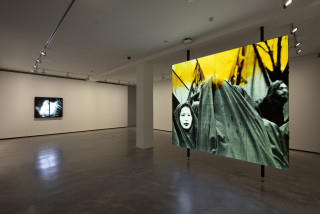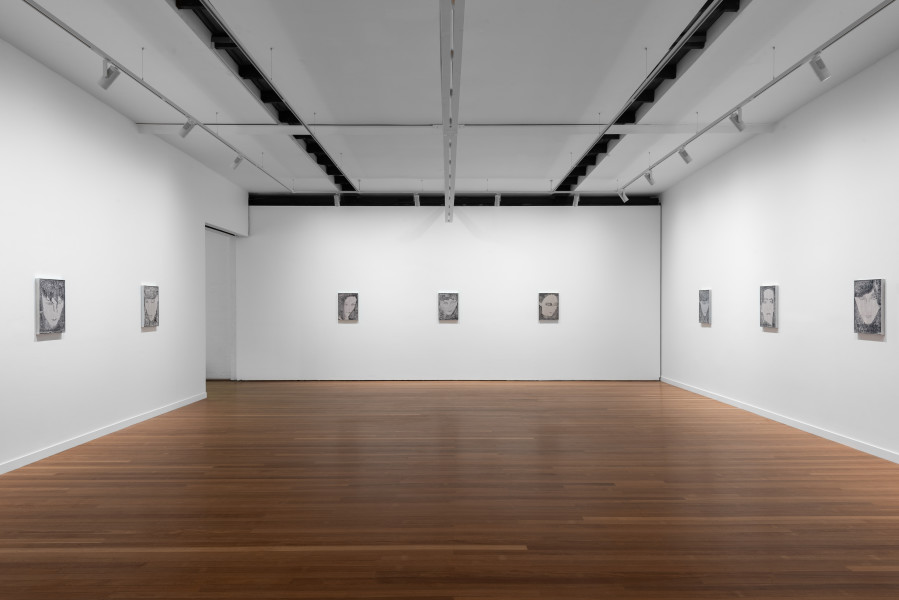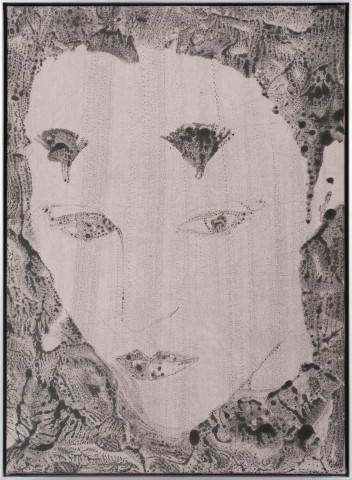Roslyn Oxley9 Gallery is delighted to present MASKEN, an exhibition of new works by David Noonan.
Exhibition Dates: 21 July – 19 August 2023
Strange true becomingsi
by Johannah Fahey, 2023
Let me begin by establishing that this is not a simple origin story. It’s not just another story about an artist’s source material. It is not an attempt to draw a straight line from A to B and create a neat chronology of the artist’s influences. This is instead a circular story. This is a story about certain characters that keep returning to us. Characters that rise out of the ashes of history again and again, resurfacing to burn ever more brightly and burnish this moment. This is a tale about recurring archetypes that are altered by time itself.
Pierrot, who was a stock character in Italian comedy theatre of the 1500s, was reborn on the Parisian stage in the late 1600s.ii He was then transformed in the early 1800s by the Bohemian-French pantomime artist Deburau, at the height of Romanticism, into the tragic clown that we are familiar with today. Pierrot’s newly whitened face became a mask. He spoke not with words but with the body, his eyes and mouth gesturing to express his laughable sorrow. As a character, he is a blank slate of sorts, reincarnated over and over, a storyteller whose pensive mood is framed and reframed by distinct ideas within different cultural movements.
There, on a neck emerging, spare,iii
In my adolescence I was born once more with a freshly powdered face. My cat-eyes heavily lined in black, my lips stained with Midnight Wine. I remember being beckoned by the New Romantics, in David Bowie’s Ashes to Ashes, those super creeps who inhabited an otherworldly lunarscape with their darkly drawn brows and highly domed heads. They leaned in frame and spoke to me directly, intoning: “I’m happy hope you’re happy too”. (But they also spoke to countless disaffected youth dwelling on the fringes of the mainstream at that time, including Noonan himself). I didn’t know the other lyrics as I couldn’t make out the words. But something still stirred in me as I heard the music transition from B to A, from flat minor to flat major. And I didn’t just hear the song; I watched it. This was music for my eyes. The black sky was mirrored in the ocean pink, the line separating air from water blurred, as it oozed across the surface of the box before MTV even existed. As the sad clown Bowie carefully traversed this chiaroscuro landscape with his sombre friends — a stylistic nod to German expressionist cinema—I felt everything all at once while at the same time feeling absolutely nothing at all. Bowie being slowly pursued by a bulldozer was a sight of pure possibility and pure dread. There was the sense of an ending, of a past slowly fading from view. There was also the sense of a beginning, a dizzying excitement as they stood there teetering on the brink of the 1980s.
Bowie has talked about filming this music video on a grey, windswept beach somewhere near Cliff End in England. A local man and his dog apparently walked between Bowie and the camera while they were shooting on a long lens, and he ruined the take. As he passed by, the director pointed at Bowie and asked him “do you know who this is?” He supposedly answered “Of course I do! It’s some cunt in a clown suit”.iv Bowie, who originally trained as a mime artist, once said: “I’m Pierrot. I’m Everyman … I’m using myself as a canvas and trying to paint the truth of our time on it. The white face, the baggy pants - they’re Pierrot, the eternal clown putting over the great sadness of 1976”.v He also later acknowledged that it was this old man’s deadpan observation that had kept him humble throughout his career.
Time and again I tell myself vi
When Noonan first showed me his early artworks for this exhibition, his incipient faces remained in my mind’s eye while the words from T.S. Eliot’s 1915 poem, The Love Song of J. Alfred Prufrock, repeated in my inner ear:
There will be time, there will be time
To prepare a face to meet the faces that you meet;vii
It’s been said that through Prufrock’s internalised stream of consciousness monologue and anxious ruminations we see inside the mind of a neurotic man, a state of neurosis that captured the wider zeitgeist. It is not clear if the fragmented world Prufrock describes is tainted by his negativity, or if it is exactly the way he sees it. Within the poem, there are some ambiguities to be disentangled. Eliot’s Prufrock has often been interpreted as a modernist Pierrot.
I have since discovered that Eliot’s Pierrot was inspired by the symbolist poet Jules Laforgue’s depiction of the same character in his collection, The Imitation of Our Lady the Moon, written in 1886. Laforgue captures Pierrot’s melancholy attitude towards not just language but the world at large by describing his mouth as “icily screaming out his laughter”.viii Laforgue’s Pierrot is a jaded romantic – a lifetime away from the New Romantics of the 1980s — a disillusioned idealist born from the pen of a Decadent.ix
From the symbolist poetry of the fin de siècle to the modernist poetry of the early 1900s and the newwave music of the late twentieth century, Pierrot — an ageless, contemplative clown — is but one persona among many who has been rewritten over time but never erased, inscribed on the skin — a made-up face, the face a mere performance — and reinscribed and reinterpreted in art, whatever the form.
The eyes are drowned in opiumx
Noonan’s faces are not Pierrots or Bowies but there are crisscrossing threads of time that connect them somehow. Noonan explores staged identities and the theatrics of selfhood. He’s interested in androgynous characters, fluid states of being, and ambiguous imagery. Throughout his work, he uses visual archives as an inspiration, so perhaps his faces were both of them… once. This is, after all, a circular story. This is a story about characters that keep returning to us. This is also the story of an artist mining his own history. Noonan began his life as an artist as a painter. He has now gone back to his own beginnings to work in this medium once more.xi
Choose any one of Noonan’s cast of faces and look at their eyes. These faces return us to his fascination with the dialogue between the figurative and the abstract. As we look at their eyes, we see that they are not fully realised as eyes. And yet, they see. And we see them. When the details of Noonan’s faces are abstracted — just as Laforgue’s “clown mouth” becomes “a singular geranium”xii — we are still able to resolve the painterly marks on the fabric as eyes and mouths. Even when these facial features are not exactly there, we fill in their shape, see an absence that never was, and the impression of these features serves to define the face as a face. And where you see a mouth, I see a bird and where there’s a bird, there’s flight.
–
i This turn of phrase is borrowed from Deleuze and Guattari’s A Thousand Plateaus (1987: 171), a tome epitomising poststructuralism in the late 1980s. They suggest “the face is a politics” (181) and “[t]he mask is now the face itself, the abstraction or operation of the face” (181).
ii Pierrot first appeared as a peasant in a bit part in Dom Juan le Festin de pierre (‘Don Juan or The Feast of the Stone’). A 1665 five-part act comedy by Molière based on the Spanish legend of Don Juan Tenorio.
iii Martin Sorrell cites this translation in his article, “Three English versions of Jules Laforgue’s ‘Pierrots’ no.1 (from L’Imitation de Notre-Dame la Lune)” [1994], and wrongly attributes it to Peter Dale in his Poems of Jules Laforgue (1986), London: Anvil Press Poetry.
iv https://www.bowiebible.com/songs/ashes-to-ashes/4/
v Jean Rook ‘Waiting for Bowie”, Daily Express, 5 May 1976: http://www.bowiegoldenyears.com/press/76-05-05-dailyexpress.html
vi Line from David Bowie’s song Ashes to Ashes (1980).
vii T.S. Eliot (1915) ‘The Love Song of J. Alfred Prufrock’ in (ed. Harriet Monroe) Poetry A Magazine of Verse, Vol. 6 (No. 3).
viii Sorell 1994 (see above).
ix The French Decadent movement rejected banal “progress” and embraced excess and artificiality in language.
x Jules Laforgue (1986) ‘L’Imitation de Notre-Dame la Lune’ in (trans. Peter Dale) Poems of Jules Laforgue. London: Anvil Press Poetry.
xi Throughout his career, Noonan has also made films, installations, collage works, tapestries, and sculptural objects.
xii Jules Laforgue (1986) ‘L’Imitation de Notre-Dame la Lune’ in (trans. Peter Dale) Poems of Jules Laforgue. London: Anvil Press Poetry.
 Group Show, Mnemosyne
Group Show, Mnemosyne
Museum of Contemporary Art, Australia, 2025
 Group Show, A Fictional Retrospective: Gertrude’s First Decade 1985–1995
Group Show, A Fictional Retrospective: Gertrude’s First Decade 1985–1995
Gertrude Contemporary, 2025
 Group Show, The First 40 Years
Group Show, The First 40 Years
Roslyn Oxley9 Gallery, 2024
 David Noonan MASKEN
David Noonan MASKEN
Roslyn Oxley9 Gallery, 2023
 Group Show, nightshifts
Group Show, nightshifts
Buxton Contemporary, 2023
 David Noonan Only when it’s cloudless
David Noonan Only when it’s cloudless
Tarrawarra Museum of Art, 2022
 David Noonan David Noonan: Stagecraft
David Noonan David Noonan: Stagecraft
Art Gallery of Ballarat, 2020-21
 David Noonan Monster Theatres
David Noonan Monster Theatres
Adelaide Biennial of Australian Art, 2020
 David Noonan A Dark and Quiet Place
David Noonan A Dark and Quiet Place
Fremantle Arts Centre, Fremantle, 2019
 David Noonan A Dark and Quiet Place
David Noonan A Dark and Quiet Place
Gertrude Contemporary, Melbourne, 2018
 David Noonan A Dark and Quiet Place
David Noonan A Dark and Quiet Place
Modern Art, London, 2017-18
 David Noonan Lead Light
David Noonan Lead Light
Roslyn Oxley9 Gallery, 2016
 David Noonan
David Noonan
Roslyn Oxley9 Gallery, 2015
 David Noonan
David Noonan
Roslyn Oxley9 Gallery, 2013
 David Noonan
David Noonan
Roslyn Oxley9 Gallery, 2011
 Group Show
Group Show
Roslyn Oxley9 Gallery, 2009-10
David Noonan Scenes
Australian Centre for Contemporary Art, Melbourne, 2009
David Noonan Altermodern
TATE Triennial, 2009
 David Noonan MARKUS
David Noonan MARKUS
Roslyn Oxley9 Gallery, 2008
David Noonan
Chisenhale Gallery, London, 2008
 Group Show, STOLEN RITUAL
Group Show, STOLEN RITUAL
Roslyn Oxley9 Gallery, 2006-07
 David Noonan Images
David Noonan Images
Roslyn Oxley9 Gallery, 2005
 Group Show, If these walls could talk
Group Show, If these walls could talk
Roslyn Oxley9 Gallery, 2005
David Noonan Films and Paintings 2001-2005
Monash Museum of Art, Melbourne, 2005
 David Noonan before and now
David Noonan before and now
Roslyn Oxley9 Gallery, 2003
 David Noonan The Likening (collaboration with Simon Trevaks)
David Noonan The Likening (collaboration with Simon Trevaks)
Roslyn Oxley9 Gallery, 2002
 Group Show, The First 20 Years
Group Show, The First 20 Years
Roslyn Oxley9 Gallery, 2002
 Group Show, more apt to be lost than got
Group Show, more apt to be lost than got
Roslyn Oxley9 Gallery, 2000































